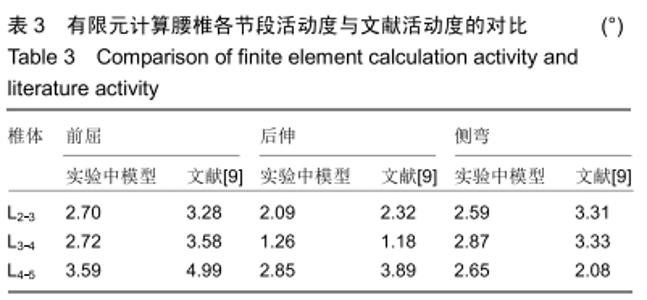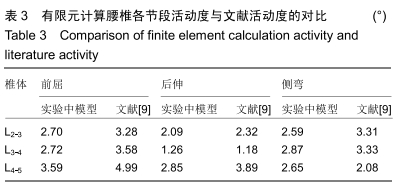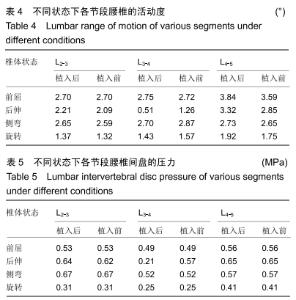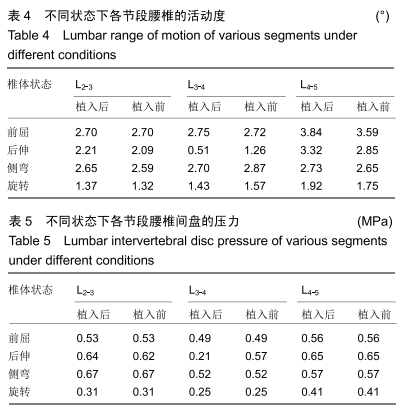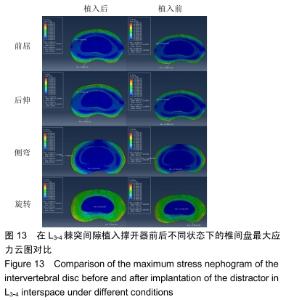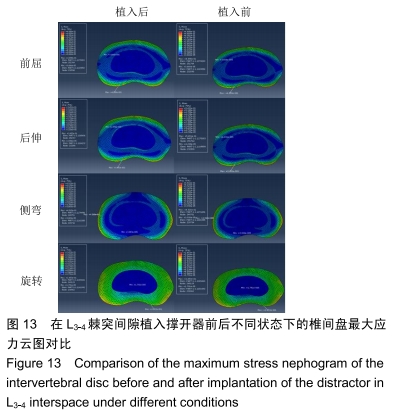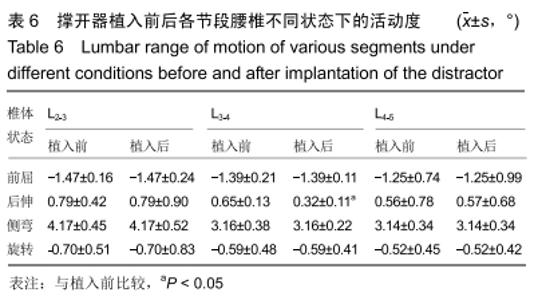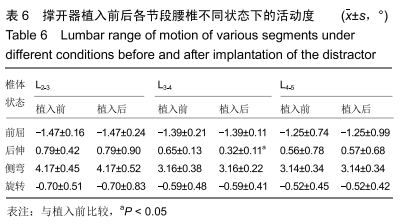[1] EKMAN P, MÖLLER H, SHALABI A, et al.A prospective randomised study on the long-termeffect of lumbar fusion on adjacent disc degeneration. Eur Spine J.2009;18(8):1175-1186.
[2] GHOBRIAL GM, WILLIAMS KA JR, ARNOLD P, et al.Iatrogenic neurologic deficit after lumbar spine surgery: A review. Clin Neurol Neurosurg.2015;139:76-80.
[3] KUMAR MN, JACQUOT F, HALL H.Long-term follow-up of functional outcomes and radiographic changes at adjacent levels following lumbar spine fusion for degenerative disc disease. Eur Spine J.2001; 10(4):309-313.
[4] HUANG RC, GIRARDI FP, LIM MR, et al.Advantages and disadvantages of nonfusion technology in spine surgery.Orthop Clin North Am.2005;36(3):263-269.
[5] 刘长征,姚庆强.不同的棘突间撑开高度对置入节段椎间盘压力分布及关节突关节应力影响的体外生物力学实验研究[J].中国骨与关节损伤杂志, 2012,27(1):26-29.
[6] 祖丹,海涌.腰椎棘突间动态稳定装置Coflex不同置入深度对相邻节段运动范围影响的生物力学研究[J].中国脊柱脊髓杂志, 2014,24(10):933-937.
[7] PATWARDHAN AG, HAVEY RM, MEADE KP.A follower load increases the load-carrying capacity of the lumbar spine in compression.Spine J.1999;24(10):1003-1009.
[8] PRADHAN BB, TURNER AW, ZATUSHEVSKY MA. Biomechanical analysis in a human cadaveric model of spinous process fxation with an interlaminar allograft spacer for lumbar spinal stenosis.Laboratory investigation.J Neurosurg Spine.2012;16(6):585-593.
[9] SHIRAZI-ADL SA,SHRIVASTAVA SC,AHMED AM.Stress analysis of the lumbar disc-body unit in compression. A three-dimensional nonlinear finite element study.Spine (Phila Pa 1976).1984;9(2):120-134.
[10] SANDERSON KB, RODITI D, GEORGE SZ.Investigating patient expectations and treatment outcome in a chronic low back pain population.J Pain Res.2012;5:15-22.
[11] TIAN H, WU A, GUO M.Adequate restoration of disc height and segmental lordosis by lumbar interbody fusion decreases adjacent segment degeneration. World Neurosurg. 2018;11(8):e856-e864.
[12] BRIDWELL KH, SEDGEWICK TA, O’BRIEN MF. The role of fusion and instrumentation in the treatment of degenerative spondylolisthesis with spinal stenosis.J Spinal Disord.1993;6(6):461-472.
[13] GHISELLI G, WANG JC, BHATIA NN. Adjacent segment degeneration in the lumbar spine. J Bone Joint Surg.2004;86-A(7):1497-1503.
[14] 张国旺,徐建广.棘突间动态固定系统防治椎间融合术后相邻节段退变中期疗效观察[J].中国骨与关节杂志,2018,2(7):98-102.
[15] 李志琳,甄平,钱济先.Coflex植入术与Quadrant通道下TLIF结合经皮Sextant椎弓根螺钉治疗退行性腰椎管狭窄症的疗效对比[J].现代生物医学展,2012,12(30):5902-5906.
[16] BELYTSCHKO TB, ANDRIACCHI TP, SCHULTZ AB, et al. Analog studies of forces in the human spine: computational techniques.J Biomech.1973;6(4):361-371.
[17] 刘洪,王文军,宋西正,等.新型脊柱外固定器的研制和生物力学测试[J].医学临床研究,2006,23(2):148-150.
[18] LINDSEY DP, SWANSON KE, FUCHS P.The effects of an interspinous implant on the kinematics of the Instrumented and adjacent levels in the lumbar spine.Spine (Phila Pa 1976).2003;28(19):2192-2197.
[19] CHEN Z,PENG B,LI D.Minimum 5-year follow-up study on the effects of the Wallis dynamic stabilization system in the treatment of lumbar degenerative disease. Chin Med J(Engl). 2014;127(20):3587-91.
[20] NECHEMSON A. Lumbar intradiscal pressure:Experimental studies on postmortem material. Acta Orthop Scand Suppl.1960;43:101-104.
[21] SHEN H, FOGEL GR, ZHU J, et al.Biomechanical analysis of different lumbar interspinous process devices: a finite element study.World Neurosurg.2019;127:e1112-e1119.
[22] 姚依村,叶冬平,梁伟国.Coflex棘突间动态稳定结合腰椎减压融合术治疗腰椎间盘退行性疾病的中期疗效[J].中国修复重建外科杂志,2019,33(3): 280-286.
[23] 梁博,徐建广.Topping-off技术防治椎间融合后邻近节段椎间盘退变实验研究[J].中国骨与关节杂志,2018,7(2):110-114.
[24] KRENN MH, PIOTROWSKI WP, PENZKOFER R.Influence of thread design on pedicle screw fixation. Laboratory investigation.J Neurosurg Spine.2008;9(1):90-95.
[25] WILKE HJ, KETTLE A, CLAES LE.Are sheep spines a valid biomechanical model for human spines.Spine (Phila Pa 1976). 1997; 22(20):2365-2374.
[26] 王沛,董强,雪原.腰椎间盘突出病变部的压力测定及其病理学意义[J].中华骨科杂志,2002,22(3):129-133.
|
